yeovil people
edwin tomkins
Solicitor
Edwin Tomkins
was the son of Rev
Thomas Tomkins
(c1761-1839) and
Mary née
Messiter
(d1830,
Yeovil). He was
born 27 December
1790,
at Blackford,
near Wincanton,
and baptised on
31 December
1790. In 1798, his
father was
recorded as
living in North
Cadbury. Edwin's
siblings were;
Elizabeth Mary
(1789-1806),
Edwin
(1790-1861),
Thomas (b1792),
Moulton
(1794-1812),
John
(1795-1858),
William
(b1799), Letitia
(1800-1801) and
Letitia Messiter
(b1803).
Elizabeth,
Edwin, Thomas
and Moulton were
all born in
Blackford, while
William, Letitia
and Letitia
Messiter were
all born in
Yeovil.
Indeed, it appears that
Rev Thomas
Tomkins moved
his family to
Yeovil around
1798. He moved
to Thornfalcon
in 1836, where
he was
“instituted by
the Bishop of
Bath and Wells
(on the petition
of John Batten
Esq) to the
rectory of Thorn
Faulcon”.
In 1807 Edwin was articled to Attorney Robert Henning of Dorchester, Dorset. In 1824 Pigot's Directory recorded Edwin as an 'Attorney of Kingstone' in Yeovil.
In 1811, Edwin's younger
brother,
Moulton, took
articles of
clerkship with
Edmund Batten
and
John Batten
of Yeovil, on
which John
Tomkins signed
as a witness.
Sadly, Moulton
Tomkins did not
complete his
clerkship as he
died in 1812 at
the age of 18
and was buried
in Yeovil on 26
March 1812.
In 1831 there were riots in England when Parliament decided against reform to give Britain's industrial cities and towns better representation. Many of the solicitors in Yeovil were active anti-Reformers and had been professional election agents of Lord Ashley. Consequently they were the first to be singled out by an angry mob on the night of Friday, 21 October 1831, in what was to become known as the Yeovil Reform Riot of 1831, who attacked the home of Edwin Tomkins' brother William, Edwin Newman, Francis Theophilus Robins, William Lambert White and John Slade.
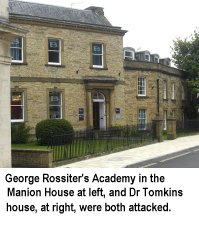 The
rioting mob, passed
George
Rossiter's
Gentlemen's
Boarding Academy
in
Mansion House
(seen at the
left of the
photograph at
left). A few windows
were broken by
the mob throwing
stones
indiscriminately.
The
rioting mob, passed
George
Rossiter's
Gentlemen's
Boarding Academy
in
Mansion House
(seen at the
left of the
photograph at
left). A few windows
were broken by
the mob throwing
stones
indiscriminately.
Magnolia House (seen at the right of the photograph at left), was the home and medical practice of Edwin's younger brother, 32-year-old Dr William Tomkins, who spent much of the riot walking the streets and trying to quell the rioters.
The crowd,
however, were
more intent on
destroying the
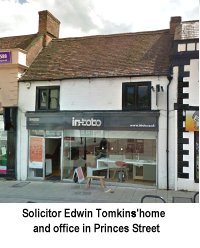 home
and law practice
of Edwin Tomkins.
home
and law practice
of Edwin Tomkins.
Shortly afterwards they assembled in larger numbers, in front of 40-year-old solicitor Edwin Tomkins' house in Princes Street, just yards away from his brother's house, and smashed every window within their reach.
It was reported the mob would have broken into the house, had they not been resisted by Edwin Tomkins and his friends, who threatened to shoot the first who entered. Tomkins remained in front of the house until he was pelted with stones (one of which weighed eleven pounds).
In 1832 the Poll Book of Milborne Port recorded Edwin Tomkins of Yeovil by virtue of owning 'a freehold garden' in Kingsbury Regis occupied by H Feaver. However Yeovil's Poll Books of both 1832 and 1834 listed Edwin by virtue of owning a freehold house in Hendford, while his brother William, a surgeon, was listed as owner of a freehold house in Kingston. The Somerset Gazette Directory of 1840 listed Edwin as an 'Attorney of Hendford', which was repeated in Hunt & Co's Directory of 1850.
Although listed in Hendford, Edwin's home and law practice was actually in today's Princes Street - although I should, perhaps, explain. In the 1850s what is today's Princes Street went by a variety of names. It was colloquially and sometimes officially referred to as 'Cattle Market' until around this time when the upper classes were taking over, but the street actually fell within three manors; Yeovil Borough, Hendford and Kingston. From today's junction with Westminster Street (at the time known as either Porter's Lane or Custard's Lane depending on who owned the bookshop on the corner at the time) as far as Old Sarum House on the corner of Park Road, the western side of the road was called Hendford because it was originally in the manor of Hendford (and, indeed, was a continuation of Hendford that starts at Hendford Hill). Beyond Park Road the western side was in the manor of Kingston and the western side was called Kingston. From about where Court Ash joins, both sides of the road was Kingston as far as the Five Crossroads. Now, coming back along the eastern side, between Court Ash and North Lane was officially Kingston but, confusingly, is invariably referred to as Hendford. From North Lane to Church Street the eastern side became known as Princes Street from around the early 1840s but was occasionally still referred to as Hendford (hence Edwin's practice is usually referred to as in Hendford, but technically wasn't). The eastern side from Church Street to High Street was in the manor of Yeovil and was known as either Cattle Market or Princes Street. From about 1850 onwards the whole gradually became known as Princes Street but the earlier names for the different parts weren't finally dropped until around 1870.
Having said all that, Edwin's home and law practice were at today's 44 Princes Street. A lifelong bachelor, Edwin was listed living there in the 1841 census with his younger sister Letitia, her husband Francis Oakley and their two sons Edwin and Moulton, as well as a male servant and a female servant. Edwin probably needed a male servant since he was blind from about 1838 and his brother-in-law, Francis Oakley almost certainly helped in the law firm as in the following census he gave his occupation as 'Attorney's General Clerk'.
Edwin served as the solicitor to the Feoffees of the Woborn Almshouse for nearly thirty years, but ill health forced him to retire from that position in the autumn of 1858. He was replaced as the almshouse's solicitor by Henry Shorland Watts.
In the 1861 census Edwin, Letitia and Francis were living at 44 Princes Street with Letitia's four children and a male and female servant. 70-year old Edwin listed his occupation as 'Retired Solicitor' and Francis gave his as Accountant, so it would appear that Edwin's law firm ended with his retirement.
Edwin Tomkins died on 1 December 1861 at Yeovil and his will was proved the following April by Thomas Tomkins (his older brother) of Piddletrenthide, Dorset, Gentleman. Edwin's effects totalled 'under £1,000'.
gallery
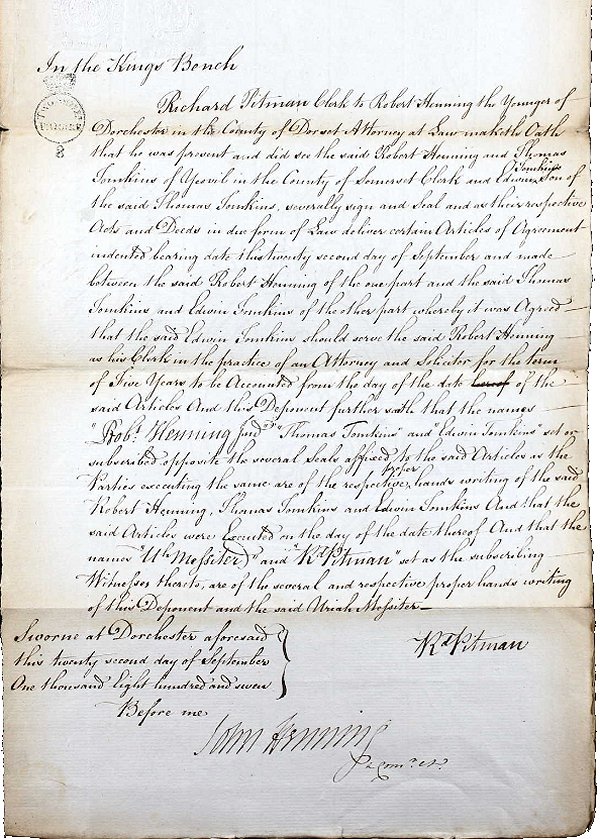
Edwin Tomkin's articles of clerkship to Robert Henning, dated 2 September 1807.
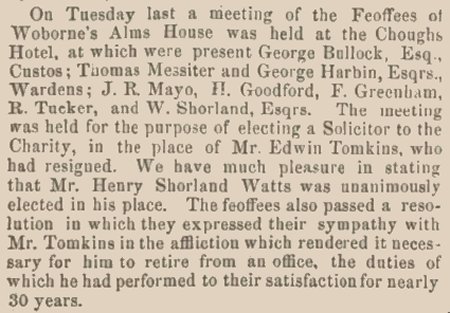
A report in the 19 October 1858 edition of the Western Flying Post concerning the retirement of Edwin from the position of solicitor to the Woborn Almshouse and being replaced by Henry Shorland Watts.
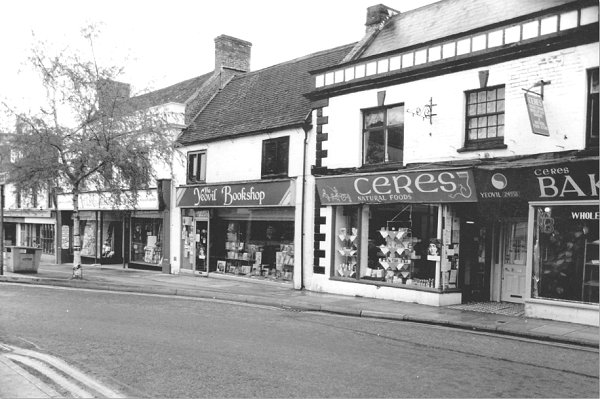
Edwin Tomkins home and law practice was in the building used by the Yeovil Bookshop in this photograph of 1990.